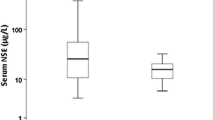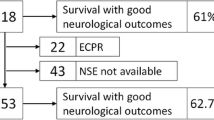Abstract
Purpose
The neuropeptide secretoneurin (SN) shows widespread distribution in the brain. We evaluated whether SN is elevated after cardiopulmonary resuscitation (CPR) and could serve as a potential new biomarker for hypoxic brain injury after CPR.
Methods
This was a prospective observational clinical study. All patients admitted to a tertiary medical intensive care unit after successful CPR with expected survival of at least 24 h were consecutively enrolled from September 2008 to April 2013. Serum SN and neuron-specific enolase were determined in 24 h intervals starting with the day of CPR for 7 days. Neurological outcome was assessed with the Cerebral Performance Categories Scale (CPC) at hospital discharge.
Results
A total of 134 patients were included with 49 % surviving to good neurological outcome (CPC 1–2). SN serum levels peaked within the first 24 h showing on average a sixfold increase above normal. SN levels were significantly higher in patients with poor (CPC 3–5) than in patients with good neurological outcome [0–24 h: 75 (43–111) vs. 38 (23–68) fmol/ml, p < 0.001; 24–48 h: 45 (24–77) vs. 23 (16–39) fmol/ml, p < 0.001]. SN determined within the first 48 h showed a receiver operating characteristic (ROC) area under the curve (AUC) of 0.753 (0.665–0.841). NSE in the first 72 h had a ROC-AUC of 0.881 (0.815–0.946). When combining the two biomarkers an AUC of 0.925 (0.878–0.972) for outcome prediction could be reached.
Conclusions
SN is a promising early biomarker for hypoxic brain injury. Further studies will be required for confirmation of these results.


Similar content being viewed by others
References
Girotra S, Nallamothu BK, Spertus JA, Li Y, Krumholz HM, Chan PS (2012) Trends in survival after in-hospital cardiac arrest. N Engl J Med 367:1912–1920
Nolan JP (2011) Optimizing outcome after cardiac arrest. Curr Opin Crit Care 17:520–526
Berdowski J, Berg RA, Tijssen JG, Koster RW (2010) Global incidences of out-of-hospital cardiac arrest and survival rates: systematic review of 67 prospective studies. Resuscitation 81:1479–1487
Kudenchuk PJ, Redshaw JD, Stubbs BA, Fahrenbruch CE, Dumas F, Phelps R, Blackwood J, Rea TD, Eisenberg MS (2012) Impact of changes in resuscitation practice on survival and neurological outcome after out-of-hospital cardiac arrest resulting from nonshockable arrhythmias. Circulation 125:1787–1794
Delhaye C, Mahmoudi M, Waksman R (2012) Hypothermia therapy: neurological and cardiac benefits. J Am Coll Cardiol 59:197–210
Nielsen N, Wetterslev J, Cronberg T, Erlinge D, Gasche Y, Hassager C, Horn J, Hovdenes J, Kjaergaard J, Kuiper M, Pellis T, Stammet P, Wanscher M, Wise MP, Aneman A, Al-Subaie N, Boesgaard S, Bro-Jeppesen J, Brunetti I, Bugge JF, Hingston CD, Juffermans NP, Koopmans M, Kober L, Langorgen J, Lilja G, Moller JE, Rundgren M, Rylander C, Smid O, Werer C, Winkel P, Friberg H (2013) Targeted temperature management at 33°C versus 36°C after cardiac arrest. N Engl J Med 369:2197–2206
Rittenberger JC, Callaway CW (2013) Temperature management and modern post-cardiac arrest care. N Engl J Med 369:2262–2263
Citerio G, Bakker J, Bassetti M, Benoit D, Cecconi M, Curtis JR, Hernandez G, Herridge M, Jaber S, Joannidis M, Papazian L, Peters M, Singer P, Smith M, Soares M, Torres A, Vieillard-Baron A, Timsit JF, Azoulay E (2014) Year in review in Intensive Care Medicine 2013: i. Acute kidney injury, ultrasound, hemodynamics, cardiac arrest, transfusion, neurocritical care, and nutrition. Intensive Care Med 40:147–159
Shinozaki K, Oda S, Sadahiro T, Nakamura M, Hirayama Y, Abe R, Tateishi Y, Hattori N, Shimada T, Hirasawa H (2009) S-100B and neuron-specific enolase as predictors of neurological outcome in patients after cardiac arrest and return of spontaneous circulation: a systematic review. Crit Care 13:R121
Wijdicks EF, Hijdra A, Young GB, Bassetti CL, Wiebe S (2006) Practice parameter: prediction of outcome in comatose survivors after cardiopulmonary resuscitation (an evidence-based review): report of the Quality Standards Subcommittee of the American Academy of Neurology. Neurology 67:203–210
Steffen IG, Hasper D, Ploner CJ, Schefold JC, Dietz E, Martens F, Nee J, Krueger A, Jorres A, Storm C (2010) Mild therapeutic hypothermia alters neuron specific enolase as an outcome predictor after resuscitation: 97 prospective hypothermia patients compared to 133 historical non-hypothermia patients. Crit Care 14:R69
Zellner T, Gartner R, Schopohl J, Angstwurm M (2013) NSE and S-100B are not sufficiently predictive of neurologic outcome after therapeutic hypothermia for cardiac arrest. Resuscitation 84:1382–1386
Fischer-Colbrie R, Laslop A, Kirchmair R (1995) Secretogranin II: molecular properties, regulation of biosynthesis and processing to the neuropeptide secretoneurin. Prog Neurobiol 46:49–70
Kirchmair R, Benzer A, Troger J, Miller C, Marksteiner J, Saria A, Gasser RW, Hogue-Angeletti R, Fischer-Colbrie R, Winkler H (1994) Molecular characterization of immunoreactivities of peptides derived from chromogranin A (GE-25) and from secretogranin II (secretoneurin) in human and bovine cerebrospinal fluid. Neuroscience 63:1179–1187
Fischer-Colbrie R, Kirchmair R, Kahler CM, Wiedermann CJ, Saria A (2005) Secretoneurin: a new player in angiogenesis and chemotaxis linking nerves, blood vessels and the immune system. Curr Protein Pept Sci 6:373–385
Moons KG, Royston P, Vergouwe Y, Grobbee DE, Altman DG (2009) Prognosis and prognostic research: what, why, and how? BMJ 338:b375
Kirchmair R, Hogue-Angeletti R, Gutierrez J, Fischer-Colbrie R, Winkler H (1993) Secretoneurin–a neuropeptide generated in brain, adrenal medulla and other endocrine tissues by proteolytic processing of secretogranin II (chromogranin C). Neuroscience 53:359–365
Jacobs I, Nadkarni V, Bahr J, Berg RA, Billi JE, Bossaert L, Cassan P, Coovadia A, D’Este K, Finn J, Halperin H, Handley A, Herlitz J, Hickey R, Idris A, Kloeck W, Larkin GL, Mancini ME, Mason P, Mears G, Monsieurs K, Montgomery W, Morley P, Nichol G, Nolan J, Okada K, Perlman J, Shuster M, Steen PA, Sterz F, Tibballs J, Timerman S, Truitt T, Zideman D (2004) Cardiac arrest and cardiopulmonary resuscitation outcome reports: update and simplification of the Utstein templates for resuscitation registries. A statement for healthcare professionals from a task force of the international liaison committee on resuscitation (American Heart Association, European Resuscitation Council, Australian Resuscitation Council, New Zealand Resuscitation Council, Heart and Stroke Foundation of Canada, InterAmerican Heart Foundation, Resuscitation Council of Southern Africa). Resuscitation 63:233–249
Nolan JP, Soar J, Zideman DA, Biarent D, Bossaert LL, Deakin C, Koster RW, Wyllie J, Bottiger B (2010) European Resuscitation Council guidelines for resuscitation 2010 section 1. Executive summary. Resuscitation 81:1219–1276
Fugate JE, Wijdicks EF, Mandrekar J, Claassen DO, Manno EM, White RD, Bell MR, Rabinstein AA (2010) Predictors of neurologic outcome in hypothermia after cardiac arrest. Ann Neurol 68:907–914
Rossetti AO, Oddo M, Logroscino G, Kaplan PW (2010) Prognostication after cardiac arrest and hypothermia: a prospective study. Ann Neurol 67:301–307
Edgren E, Hedstrand U, Kelsey S, Sutton-Tyrrell K, Safar P (1994) Assessment of neurological prognosis in comatose survivors of cardiac arrest. BRCT I Study Group. Lancet 343:1055–1059
Stiell IG, Nesbitt LP, Nichol G, Maloney J, Dreyer J, Beaudoin T, Blackburn J, Wells GA (2009) Comparison of the cerebral performance category score and the health utilities index for survivors of cardiac arrest. Ann Emerg Med 53:241–248
Pencina MJ, D’Agostino RB Sr, D’Agostino RB Jr, Vasan RS (2008) Evaluating the added predictive ability of a new marker: from area under the ROC curve to reclassification and beyond. Stat Med 27:157–172
Shyu WC, Lin SZ, Chiang MF, Chen DC, Su CY, Wang HJ, Liu RS, Tsai CH, Li H (2008) Secretoneurin promotes neuroprotection and neuronal plasticity via the Jak2/Stat3 pathway in murine models of stroke. J Clin Invest 118:133–148
Marti E, Ferrer I, Blasi J (2001) Differential regulation of chromogranin A, chromogranin B and secretoneurin protein expression after transient forebrain ischemia in the gerbil. Acta Neuropathol 101:159–166
Egger M, Schgoer W, Beer AG, Jeschke J, Leierer J, Theurl M, Frauscher S, Tepper OM, Niederwanger A, Ritsch A, Kearney M, Wanschitz J, Gurtner GC, Fischer-Colbrie R, Weiss G, Piza-Katzer H, Losordo DW, Patsch JR, Schratzberger P, Kirchmair R (2007) Hypoxia up-regulates the angiogenic cytokine secretoneurin via an HIF-1alpha- and basic FGF-dependent pathway in muscle cells. FASEB J 21:2906–2917
Ischia R, Gasser RW, Fischer-Colbrie R, Eder U, Pagani A, Cubeddu LX, Lovisetti-Scamihorn P, Finkenstedt G, Laslop A, Winkler H (2000) Levels and molecular properties of secretoneurin-immunoreactivity in the serum and urine of control and neuroendocrine tumor patients. J Clin Endocrinol Metab 85:355–360
Bottiger BW, Mobes S, Glatzer R, Bauer H, Gries A, Bartsch P, Motsch J, Martin E (2001) Astroglial protein S-100 is an early and sensitive marker of hypoxic brain damage and outcome after cardiac arrest in humans. Circulation 103:2694–2698
Mortberg E, Zetterberg H, Nordmark J, Blennow K, Rosengren L, Rubertsson S (2011) S-100B is superior to NSE, BDNF and GFAP in predicting outcome of resuscitation from cardiac arrest with hypothermia treatment. Resuscitation 82:26–31
Rosen H, Sunnerhagen KS, Herlitz J, Blomstrand C, Rosengren L (2001) Serum levels of the brain-derived proteins S-100 and NSE predict long-term outcome after cardiac arrest. Resuscitation 49:183–191
Tiainen M, Roine RO, Pettila V, Takkunen O (2003) Serum neuron-specific enolase and S-100B protein in cardiac arrest patients treated with hypothermia. Stroke 34:2881–2886
Haimoto H, Hosoda S, Kato K (1987) Differential distribution of immunoreactive S100-alpha and S100-beta proteins in normal nonnervous human tissues. Lab Invest 57:489–498
Hayashida H, Kaneko T, Kasaoka S, Oshima C, Miyauchi T, Fujita M, Oda Y, Tsuruta R, Maekawa T (2010) Comparison of the predictability of neurological outcome by serum procalcitonin and glial fibrillary acidic protein in postcardiac-arrest patients. Neurocrit Care 12:252–257
Rana OR, Schroder JW, Baukloh JK, Saygili E, Mischke K, Schiefer J, Weis J, Marx N, Rassaf T, Kelm M, Shin DI, Meyer C, Saygili E (2013) Neurofilament light chain as an early and sensitive predictor of long-term neurological outcome in patients after cardiac arrest. Int J Cardiol 168:1322–1327
Gilje P, Gidlof O, Rundgren M, Cronberg T, Al-Mashat M, Olde B, Friberg H, Erlinge D (2014) The brain-enriched microRNA miR-124 in plasma predicts neurological outcome after cardiac arrest. Crit Care 18:R40
Schoerkhuber W, Kittler H, Sterz F, Behringer W, Holzer M, Frossard M, Spitzauer S, Laggner AN (1999) Time course of serum neuron-specific enolase. A predictor of neurological outcome in patients resuscitated from cardiac arrest. Stroke 30:1598–1603
Casmiro M, Maitan S, De PF, Cova V, Scarpa E, Vignatelli L (2005) Cerebrospinal fluid and serum neuron-specific enolase concentrations in a normal population. Eur J Neurol 12:369–374
Zandbergen EG, de Haan RJ, Hijdra A (2001) Systematic review of prediction of poor outcome in anoxic-ischaemic coma with biochemical markers of brain damage. Intensive Care Med 27:1661–1667
Ramont L, Thoannes H, Volondat A, Chastang F, Millet MC, Maquart FX (2005) Effects of hemolysis and storage condition on neuron-specific enolase (NSE) in cerebrospinal fluid and serum: implications in clinical practice. Clin Chem Lab Med 43:1215–1217
Oksanen T, Tiainen M, Skrifvars MB, Varpula T, Kuitunen A, Castren M, Pettila V (2009) Predictive power of serum NSE and OHCA score regarding 6-month neurologic outcome after out-of-hospital ventricular fibrillation and therapeutic hypothermia. Resuscitation 80:165–170
Tiainen M, Roine RO, Pettila V, Takkunen O (2003) Serum neuron-specific enolase and S-100B protein in cardiac arrest patients treated with hypothermia. Stroke 34:2881–2886
Lemiale V, Dumas F, Mongardon N, Giovanetti O, Charpentier J, Chiche JD, Carli P, Mira JP, Nolan J, Cariou A (2013) Intensive care unit mortality after cardiac arrest: the relative contribution of shock and brain injury in a large cohort. Intensive Care Med 39:1972–1980
Acknowledgments
We thank Marianne Schmid, Markus Theurl, Daniel Marlin and Caroline Linhardt for their support.
Conflicts of interest
The authors declare that they have no conflicts of interest.
Author information
Authors and Affiliations
Corresponding author
Additional information
Take home message: The neuropeptide secretoneurin is a biomarker for hypoxic brain injury which is rapidly released in the first 24 h after cardiopulmonary resuscitation. Owing to its specific kinetics and properties, secretoneurin may significantly improve prediction of neurological outcome in combination with the existing marker neuron-specific enolase. Further studies in the context of SN and CPR are warranted to confirm these results.
Electronic supplementary material
Below is the link to the electronic supplementary material.
Rights and permissions
About this article
Cite this article
Hasslacher, J., Lehner, G.F., Harler, U. et al. Secretoneurin as a marker for hypoxic brain injury after cardiopulmonary resuscitation. Intensive Care Med 40, 1518–1527 (2014). https://doi.org/10.1007/s00134-014-3423-4
Received:
Accepted:
Published:
Issue Date:
DOI: https://doi.org/10.1007/s00134-014-3423-4




